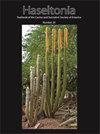Areole Changes During Bark Formation for Columnar Cactus Species
IF 0.4
4区 生物学
Q2 PLANT SCIENCES
引用次数: 0
Abstract
Abstract: Bark coverage occurs on stems of more than twenty species of columnar cacti. This report documents characteristics of areoles and spines from central Mexico with bark coverage percentages on five columnar cactus species (Cephalocereus columna-trajani, Neobuxbaumia macrocephala, N. mezcalaensis, N. tetetzo, and Pachycereus hollianus). Older cacti (more than 4 m tall) had fewer original spines than younger cacti (less than 2 m tall). For cacti taller than 4 m, loss of the original spines was positively correlated with bark coverage. For three species, loss of the original spines occurred with about 75% for bark coverages. Four of the five species studied produced hair-like spines at areoles. Three of the five species produced emergent spines. Most emergent spines were associated with hair-like spines. The presence of hair-like and emergent spines (spines that emerged on mature cactus surfaces) was not well correlated with percentages of bark coverage. Hair-like spines have been noted previously, but no function has been attributed to them. This is the first report with a description of emergent spines on tall, long-lived columnar cactus species.柱状仙人掌树皮形成过程中微孔的变化
摘要:二十多种柱状仙人掌的茎上都有树皮覆盖。本文记录了墨西哥中部5种柱状仙人掌(Cephalocereus columna-trajani, Neobuxbaumia macrocephala, N. mezcalaensis, N. tetetzo和Pachycereus hollianus)的针孔和刺的特征和树皮覆盖率百分比。老的仙人掌(超过4米高)比年轻的仙人掌(不到2米高)有更少的原始刺。对于4 m以上的仙人掌,原始刺的损失与树皮盖度呈正相关。有三种树的树皮覆盖率在75%左右时失去了原有的棘刺。在被研究的5个物种中,有4个在微孔处长出了毛发状的刺。五个物种中有三个产生了突起的刺。大多数涌现出的刺与毛发状刺有关。毛状刺和突现刺(在成熟仙人掌表面出现的刺)的存在与树皮覆盖率的百分比没有很好的相关性。以前已经注意到毛发状的刺,但没有归因于它们的功能。这是第一份描述高大、长寿的柱状仙人掌物种上出现刺的报告。
本文章由计算机程序翻译,如有差异,请以英文原文为准。
求助全文
约1分钟内获得全文
求助全文
来源期刊

Haseltonia
生物-植物科学
CiteScore
3.00
自引率
6.70%
发文量
11
审稿时长
>12 weeks
期刊介绍:
Haseltonia, Yearbook of the Cactus and Succulent Society of America, is published in full color and features peer-reviewed articles about all aspects of cacti, succulents and their environs. Topics include current research and conservation reports, new species descriptions and lengthy taxonomic revisions, historical and biographical notes, chemical and cytological studies, evolutionary biology and ethnobotanical reports, propagation and pest control methods, and pollinator studies. Serious students of the world''s succulent flora, botanists, taxonomists, researchers and horticulturalists will all find Haseltonia a valuable addition to their book collection.
 求助内容:
求助内容: 应助结果提醒方式:
应助结果提醒方式:


